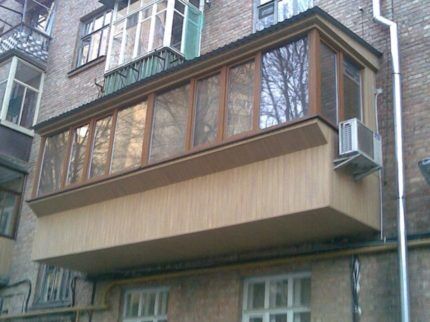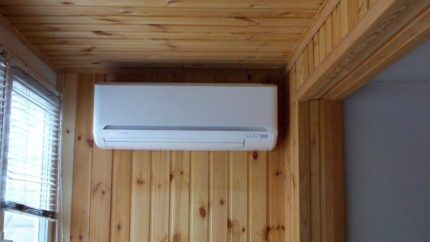How to install air conditioning on a loggia and glazed balcony: instructions and valuable recommendations
A modern split system in an apartment will help create more comfortable living conditions: regulate the optimal temperature, provide comfortable humidity and clean the air. But during the installation of an air conditioning system, you may encounter some difficulties. We will tell you how to install an air conditioner on a loggia correctly.
The article we have proposed describes in detail the specifics of the design of a household climate control system. Features of the installation of units that provide cooling or heating of the air mass in the room are given. To help independent home craftsmen, common mistakes made during installation work are listed.
The content of the article:
What is a split system?
The air conditioner consists of 2 separate blocks. One unit is installed indoors. The other is installed outside - usually on the facade of the house according to regulations. The modules are connected to each other by copper freon tubes and wires.
Cooling/heating of the air in the room is carried out by moving the refrigerant through the tubes. Refrigerant absorbs or releases heat when it changes from gaseous to liquid phase and vice versa.
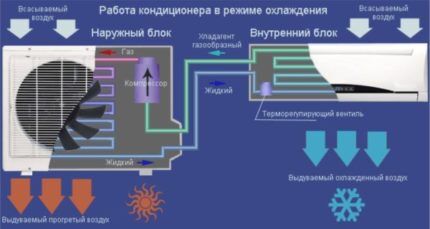
According to manufacturers' recommendations, the indoor unit should be mounted on a wall under the ceiling, since the warmest air collects there. In addition, there is one more condition - the indoor unit must be mounted close to the outer wall of the room in order to minimize the distance to the external module.
The outdoor unit is installed on the facade in accordance with SNiP 2.04.05-91 standards. However, in some cases it is not possible to install the module on the façade.
Reasons for installing an air conditioner on a balcony
Unfortunately, sometimes there are situations when the external module cannot be installed on the facade:
- the air conditioning unit disrupts the appearance of the building;
- the building is classified as a historical monument;
- for technical reasons, it is impossible to install an external block on the external walls of the building;
- there is no permission to install an air conditioner on the wall of an apartment building.
In the above cases, if the indoor air conditioner unit is installed in a room with a balcony, then it the external unit is mounted on the balcony or loggia. And it doesn’t matter - open or glazed.
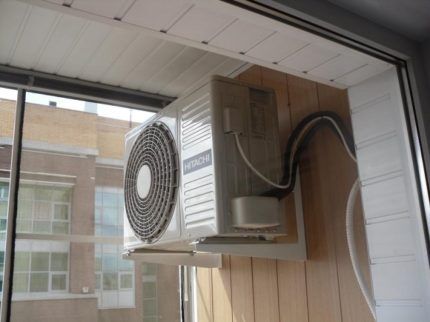
Installing an external air conditioner unit on a loggia or balcony has a number of advantages:
- the installation process is less expensive: no work at height is required;
- the block body is protected from negative weather factors: wind, snow, rain;
- the distance between the air conditioner modules is reduced;
- simplifies maintenance, cleaning and repair.
However, there are also disadvantages to this installation option. Let's take a closer look at them.
Features of location on the balcony/loggia
Everything is clear with installing an air conditioner on an open, unglazed balcony. This is the only 100% acceptable option without any disadvantages.
On an open loggia or balcony, the air conditioner has constant access to fresh air and can operate at full power without overheating. During installation, only one requirement must be observed - the minimum length of the line.
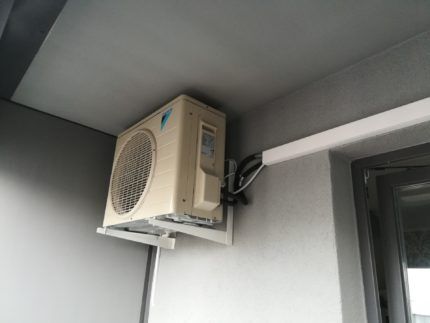
It’s another matter if the balcony or loggia is glazed. As a rule, this option goes against all the requirements of the manufacturers. The air conditioning process requires free access of air, which is difficult in the presence of a glazing structure.
In this case, the owner will have to provide forced exhaust air and an additional influx of fresh air, otherwise the equipment will constantly turn off due to overheating. This means that at least 3 window sashes on the loggia must be open while the equipment is operating, and the unit itself must be placed opposite one open sashes.
In addition, the bulky module housing can take up a lot of space and produce noise. The sound from the operating unit will be reflected from the walls of the balcony and will be felt somewhat louder compared to installation on the street. The noise intensity depends on the split system.

The ideal solution to all problems that arise is to dismantle the glazing for the summer period. At the end of the season, the glazing is returned to its place.As a rule, this is not a particularly resource-intensive procedure, even if PVC windows are installed on the balcony.
Another convenient installation method is on the balcony parapet. In this case, the equipment is placed on brackets. And it is advisable to place it on the side where the sun's rays fall least. Legally, this is not the façade of a building.
In this case, there are no problems with free air movement. However, as when installed on a facade, the block can be torn off by a block of ice falling from the roof. Therefore, it is additionally recommended installation of the visor above the device.
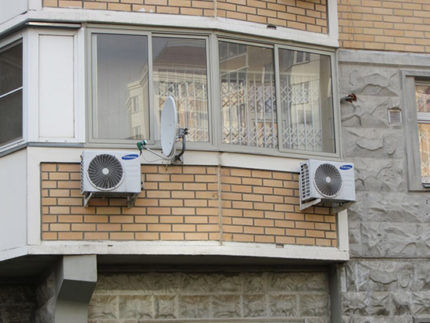
It should be noted right away that SNiPs have a restriction prohibiting hanging objects weighing more than 30 kg on the railings. If this figure is exceeded, you will have to pay a fine, even if you weld brackets on the outside or install additional supports.
If there is only one loggia, but several rooms need to be cooled, instead of several household air conditioners It is recommended to purchase a multi-split system to which you can connect several indoor units.
Installation instructions for air conditioning units
Let's look at the best ways to install split systems. Let us immediately note that the most common option for installing an external unit - on the wall - is the most unsuccessful in terms of efficiency.
Firstly, with this method of arrangement the air on the loggia and, accordingly, in the room will become very hot. When the maximum temperature reaches 45 degrees, the air conditioner will simply turn off automatically.
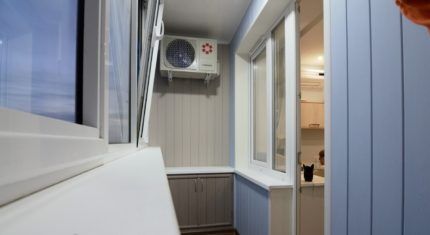
Secondly, the windows with this module arrangement must be constantly open. In calm weather, this cooling method will also be ineffective. The only option to increase the efficiency of the split system is to remove the glazing for the summer. Therefore, we will not consider this option for installing the outdoor unit.
Installation of an external unit inside a loggia
If the balcony is not only glazed, but also insulated, and covered with clapboard on top, it is easier to install the external unit on the floor. The best option is to use one corner equipped space. Since a conventional split takes air from the rear and sides and exhausts it forward, it is necessary to ensure separation of air flows so that the warm exhaust air does not mix with the intake air.
When installed in a corner, air is exhausted through the front wall of the balcony, and through the end there is a fence. To ensure better sound insulation, the housing must be closed in a sealed box with a door for maintenance.
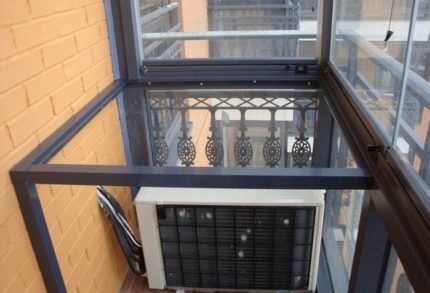
This achieves the following design advantages:
- strong reliable foundation;
- free air circulation;
- due to the absence of a wall, the equipment does not overheat;
- minimal noise.
Of course, the box eats up part of the usable area, but its upper surface can also be used.
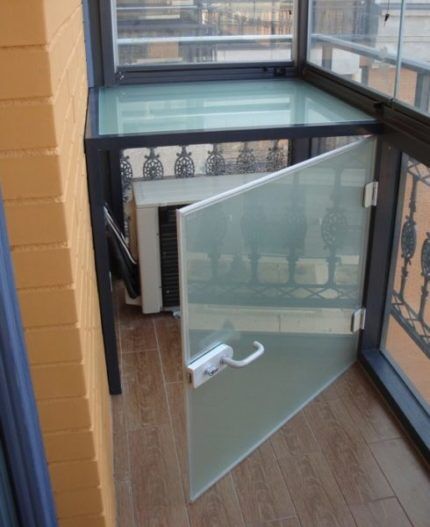
Let's look at how to properly close air conditioners on balconies:
- A place is being prepared to place the external remote unit.
- A large hole is cut in the wall for unhindered air circulation.
- To accommodate the body, 2 U-shaped supports from the corners are welded. The supports can be secured to anchors. Supports are necessary for shock absorption during vibration and additional air circulation. In addition, condensation will flow down.
- The outdoor module is installed on stands.
- A sealed box made of noise-insulating materials with one drop-down wall for maintenance is installed.
- Channels for highways are drilled in the box and in the wall adjacent to the room.
- Freon tubes and cables connecting the external and internal modules are installed.
- Communications are closed with a cable channel.
- The drainage line is connected.
- The system is being tested.
After operating the split system for 2-3 days, you can assess the need for noise insulation improvements.
A simpler option for installing an external unit is without a box. This method is justified in new houses, where similar rooms of neighbors may be located to the right and left of the balcony. In this case, the module is installed in exactly the same way on the floor of the loggia/balcony facing the balcony grille.
The decorative panel with insulation is cut to the size of the air conditioner - the joint is sealed after installation. No box is installed. The hot air exhaust goes to the street, and the fence comes from the loggia.
The doors must be open during operation of the device.With this installation method, noise insulation is not provided, so you need to immediately purchase an inverter model of an air conditioner with a low noise level.
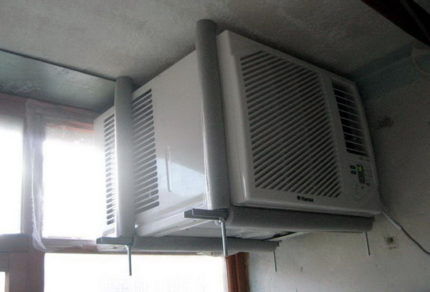
If the floor on the balcony is strategically important, the unit can be installed on consoles attached to the ceiling. This is a more technically complex option, which also involves working with glass, but it will free up space below.
Installation of an external unit on a parapet
A popular option for installing air conditioners is on balcony railings. Of course, according to building regulations there is a load limit. You can hang no more than 30 kg on the railing, and the outdoor unit can weigh up to 60 kg or even more.
However, as they say, the severity of the requirements of the Housing Code is compensated by the optionality of their implementation. In any case, if the module is large and heavy, but the decision has been made to install it on the loggia railing, you need to mentally prepare for a situation where you will need to pay a fine.
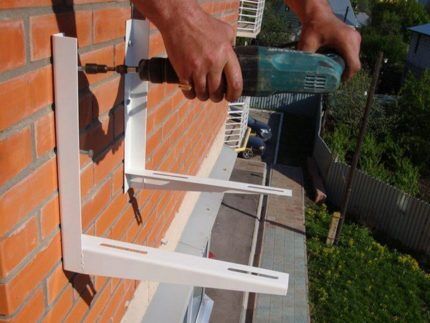
The outdoor unit must be hung on the side where the indoor module is installed. This is necessary to reduce the length of the freon route. Depending on the age and degree of wear and tear of the house, and with it the balcony or loggia, the fence will have to be strengthened.
If the parapet is made of reinforced concrete or brick, it is fastened to anchors with a diameter of 10 mm and a length of 6-8 cm. If the fence is made of rods or sheet material on a frame, then the consoles are attached to the frame.
A good option is to weld the consoles to the frame. Another option for installing consoles is through bolting. A steel plate is mounted on the inside of the fence, over which the load will be distributed.
Installation of the indoor unit
In some cases, it becomes necessary to move the indoor unit onto the loggia. There may be several reasons: it does not fit into the interior design, there is no free space, parents are afraid of catching a cold in their children. Sometimes apartment owners use a large loggia as another room - a study, a relaxation area, or part of the kitchen.
If cooling of the room from the loggia is required, the module must be installed opposite the door to the room at a height of 1.7-2 m. The door to the room, of course, must be open. If the split system is installed at the end of the loggia, the air flow will circulate only in it past the door. This is an excellent option if you need to cool the loggia, but not the adjacent room.
For this method of mounting, you will have to take into account, in addition to the area of the room, the area of the loggia, so most likely you will have to buy an air conditioner of higher power. Additionally, you will have to attach a metal frame or hangers.
How to install a split system on a loggia with this arrangement:
- Suspensions are bent from a metal profile or corner.
- The hangers are attached to the concrete ceiling with anchors.
- The module is placed in such a way that the blinds are directed towards the door.
- A power source is provided: a socket is installed or a cable is laid from the room.
- Connect the cables leading to the outdoor unit.
- The drainage line is connected.
- The equipment is being tested.
It is undoubtedly much more convenient and efficient to install the indoor unit in a room with a balcony. However, if any problems arise, it is permissible to move the indoor unit onto the balcony. In this case, it is installed on the floor in a box.
Specifics of condensate drainage
Condensation from the air conditioner must not be discharged uncontrollably onto the street. Drops of it can drip onto the heads of passers-by or fall on the neighbors' ebb tides and disturb them with their knocking. In addition, condensation can cause surfaces to become wet and mold to appear on them. In some cases, this can even cause the destruction of facade tiles.
Therefore, the condensate drainage route must be laid:
- to the nearest drainpipe;
- into the sewer;
- into a container on the balcony that requires regular emptying.
The method of discharging liquid through a drainpipe has its drawbacks. In addition to installation difficulties, the drain may become clogged and water will flow back into the module. Therefore, the best option is to drain the drainage into the sewer. Drainage route design is usually done during renovation.
There are 2 main requirements for the route:
- the slope along the entire length of the horizontal sections of the route is not less than 3 degrees;
- turning angle - 45 degrees.
Drainage pipes are laid both outside along the floor base and inside the wall along grooves with their subsequent sealing with repair mortars.
To prevent unpleasant odors from the sewer system from penetrating into the room, a water seal in the form of a sewer siphon is made at the junction of the drainage system pipes and the sewer system pipes. The easiest option is to bend the corrugated pipe of the drainage route into the shape of the letter “S”.

If the length of the drainage system is long or it is difficult to provide the required slope, you can install a drainage pump. Pumps for household air conditioners are sold as a separate item and are easy to install. The pump capacity should not be less than the amount of condensate produced by the air conditioner. The parameter is indicated in the technical documentation.
Errors in installing an air conditioner on a balcony
The biggest mistake made by air conditioner installers is violating the standards stipulated by the city authorities or the Criminal Code. If the house is included in the register of historical or architectural monuments or some neighbor decides that noise or vibration from air conditioner, and the owner of the apartment has not completed permitting documents, then you can receive a fine.
The second common mistake is operating the air conditioner on a glassed-in loggia with the windows constantly closed, which will sooner or later lead to overheating of the equipment. An incorrectly chosen location for installing the indoor unit will reduce the efficiency of the system.

It is also necessary to pay attention to the installation and fastening of supports. The air conditioner operates with vibration and to reduce it it is necessary to install shock-absorbing pads. In addition, fasteners and support devices must be checked periodically, as vibration can cause the nuts to loosen.
Conclusions and useful video on the topic
Watch a video about installing an air conditioner with an external unit on the parapet of a loggia:
Of course, installing an external or internal air conditioning unit inside a balcony is often a necessary measure. A management company or a developer in a new building may recommend installing a split system on the loggia in order to preserve the integral appearance of the building’s facade or the house may belong to a historical heritage.
In this case, the apartment owner is faced with a whole bunch of problems - the need to separate air flows and ensure cooling of the unit. All these, of course, are surmountable difficulties, but if possible, it is better to install the outdoor unit on the facade in close proximity to the balcony to facilitate maintenance.
Tell us about how you installed the air conditioner on your balcony or loggia. Share the nuances of the process and technological subtleties that you know. Please leave comments in the block below, ask questions, post photos on the topic of the article.
